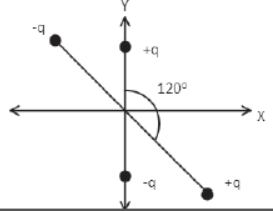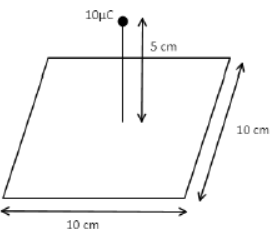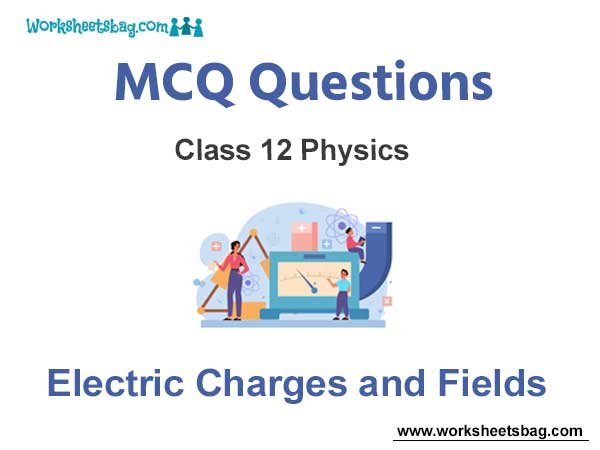Please refer to Electric Charges and Fields MCQ Questions Class 12 Physics below. These MCQ questions for Class 12 Physics with answers have been designed as per the latest NCERT, CBSE books, and syllabus issued for the current academic year. These objective questions for Electric Charges and Fields will help you to prepare for the exams and get more marks.
Electric Charges and Fields MCQ Questions Class 12 Physics
Please see solved MCQ Questions for Electric Charges and Fields in Class 12 Physics. All questions and answers have been prepared by expert faculty of standard 12 based on the latest examination guidelines.
MCQ Questions Class 12 Physics Electric Charges and Fields
Question. The force per unit charge is known as
(a) electric flux
(b) electric current
(c) electric potential
(d) electric field
Answer
D
Question. Which of the following figures represent the electric field lines due to a single negative charge?

Answer
B
Question. SI unit of permittivity of free space is
(a) Farad
(b) Weber
(c) C2N–1 m–2
(d) C2N–1m–2
Answer
C
Question. Electric field lines provide information about
(a) field strength
(b) direction
(c) nature of charge
(d) all of these
Answer
D
Question. The unit of electric dipole moment is
(a) newton
(b) coulomb
(c) farad
(d) debye
Answer
D
Question. A charge Q is placed at the centre of the line joining two point charges +q and +q as shown in the figure. The ratio of charges Q and q is

(a) 4
(b) 1/4
(c) – 4
(d) – 1/4
Answer
D
Question. Consider a region inside which, there are various types of charges but the total charge is zero. At points outside the region
(a) the electric field is necessarily zero.
(b) the electric field is due to the dipole moment of the charge distribution only.
(c) the dominant electric field is inversely proportional to r3, for large r (distance from origin).
(d) the work done to move a charged particle along a closed path, away from the region will not be zero.
Answer
C
Question. The SI unit of electric flux is
(a) N C–1 m–2
(b) N C m–2
(c) N C–2 m2
(d) N C–1 m2
Answer
D
Question. The surface considered for Gauss’s law is called
(a) Closed surface
(b) Spherical surface
(c) Gaussian surface
(d) Plane surface
Answer
C
Question. Identify the correct statement about the given figures :
(a) The electric flux is maximum in figure (ii).
(b) The electric flux in figure (i) is the least.
(c) The electric flux is same in figure (i) and (iv) but it is smaller than that in figure (iii).
(d) The electric flux is same through all the surfaces shown in the above figures.
Answer
D
Question. Two small identical electric dipoles, each of dipole moment p are kept as shown. This system is subjected to an external uniform electric field E directed along Y axis. The magnitude and direction of the torque acting on the system is

(a) pE along X axis
(b) pE/2 along Z axis
(c) √3 pE/2 along Z axis
(d) pE/2 along negative Z axis.
Answer
C
Question. Two point charges A and B having charges +Q and -Q respectively are placed at a distance r from each other. The force of attraction between them is F. If 25% charge of A is transferred to B, then force between the charges becomes

(a) 4F/3
(b) F
(c) 9F/16
(d) 16F/9
Answer
C
Question. A spherical surface of radius r encloses a dipole having charges +Q and -Q. What is the electric flux through the sphere?
(a) zero
(b) Q / εo
(c) 2Q / εo
(d) Q/ 4πr2
Answer
A
Question. A uniform electric field is given by , 𝐸 ⃗ = 3 × 10 3 𝑖̂ N/C. What is the flux of this field through a square of side 10cm whose plane is parallel to the YZ plane?
(a) 0
(b) 3 Nm2 /C
(c) 30 Nm2 /C
(d) 0.3 Nm2 /C
Answer
C
Question. Two point charges 3μC and -3μC are located 20cm apart in vacuum. The electric field at the mid-point of the line joining these two charges is
(a) Zero
(b) 2.7 × 106 N/C
(c) 5.4 × 106 N/C
(d) 10.2 × 106 N/C
Answer
C
Question. The angle between dipole moment and electric field due to a dipole on its equatorial line is
(a) 0o
(b) 90o
(c) 180o
(d) 45o
Answer
C
Question. An electron of mass me initially at rest moves through a certain distance in a uniform electric field in time t1. A proton of mass mp also initially at rest, moves through equal distance in the same electric field in time t2.
Neglecting the effect of gravity, the ratio t1 : t2 is nearly equal to
(a) 1836
(b) me/mp
(c) (me/mp)1/2
(d) (mp/me)1/2
Answer
D
Question. A 10μC charge is kept 5 cm directly above the centre of a square of side 10cm as shown. What is the electric flux through the square?
(a) 1.8 × 102 m2 N/C
(b) 1.8 × 104 m2 N/C
(c) 1.8 × 105 m2 N/C
(d) 1.8 m2 N/C
Answer
C
Question. Charges q1 and q2 are separated by some distance in air. Electrostatic force between them is F. If these charges are kept in a medium of permittivity ε at same distance, then the force between the charges will be
(a) εo F/ ε
(b) ε F/ εo
(c) F/ ε εo
(d) F ε εo
Answer
A
Question. Which of the following statements is not true about Gauss’s law?
(a) Gauss’s law is true for any closed surface.
(b) The term q on the right side of Gauss’s law includes the sum of all charges enclosed by the surface.
(c) Gauss’s law is not much useful in calculating electrostatic field when the system has some symmetry.
(d) Gauss’s law is based on the inverse square dependence on distance contained in the coulomb’s law.
Answer
C
Question. The total flux through the faces of the cube with side of length a if a charge q is placed at corner A of the cube is


Answer
A
Assertion and Reasoning Based Questions :
a : If Assertion and reason are both true and reason is the correct explanation for Assertion.
b : If Assertion and reason are both true but reason is not the correct explanation for Assertion.
c : If Assertion is true but reason is false.
d : If Assertion is false but Reason is true.
Question. Assertion (A) : Electric force acting on a proton and an electron moving in a uniform electric field is same whereas the acceleration of the electron is more than that of the proton.
Reason (R) : Charge on an electron and a proton have same magnitude but the masses of proton and electron are different
Answer
A
Question. Assertion (A) : Electric field intensity is a vector quantity.
Reason (R) : Electric field is equal to force per unit charge and force is a vector quantity.
Answer
A
Question. Assertion (A) : Electric flux emerging out of a surface is 8 × 103 Nm2/C and entering the surface is 2 ×103 Nm2/C. The charge enclosed by the surface is positive.
Reason (R) : Electric flux is a scalar quantity
Answer
B
Question. Assertion (A) : Charge is quantised.
Reason (R) : A charge of less than 1 C is not possible
Answer
C
Question. Assertion (A) : A point charge is lying at the centre of a cube. The electric flux through each surface of the cube is 1/6th of the total flux though the cube.
Reason (R) : Electric flux is a scalar quantity.
Answer
B
Question. Assertion (A) : Charging by friction is due to transfer of charges.
Reason (R) : Mass of a body decreases slightly when it gets negatively charged
Answer
C
Question. Assertion (A) : Electric field lines do not form closed loops.( in case of EMI they can form close loop)
Reason(R) : Electric field lines are always normal to the surface of a conductor.
Answer
B
Question. Assertion (A): The net force and net torque on an electric dipole kept in an external uniform electric field is always zero.
Reason (R) : Electric dipole moment is a vector quantity directed from -q to +q.
Answer
D
Read the two statements Assertion (A) and Reason (R) carefully to mark the correct option out of the options given below:
(a) Assertion and Reason both are correct statements and Reason is correct explanation for Assertion.
(b) Assertion and Reason both are correct statements but Reason is not correct explanation for Assertion.
(c) Assertion is correct statement but Reason is wrong statement.
(d) Assertion is wrong statement but Reason is correct statement
Question. Assertion: If there exists coulomb attraction between two bodies, both of them may not be charged.
Reason: In coulomb attraction two bodies are oppositely charged.
Answer
B
Question. Assertion: Electric force acting on a proton and an electron, moving in a uniform electric field is same, where as acceleration of electron is 1836 times that a proton.
Reason: Electron is lighter than proton.
Answer
A
Question. Assertion: As force is a vector quantity, henceelectric field intensity is also a vector quantity.
Reason: The unit of electric field intensity is newton per coulomb.
Answer
B
Question. Assertion: The surface densities of two spherical conductors of different radii are equal. Then the electric field intensities near their surface are also equal.
Reason: Surface charge density is equal to charge per unit area.
Answer
B
Question. Assertion: The electric lines of forces diverges from a positive charge and converge at a negative charge.
Reason: A charged particle free to move in an electric field always move along an electric line of force.
Answer
C
Question. Assertion: Range of Coulomb force is infinite.
Reason: Coulomb force acts between two charged particles.
Answer
B
Question. Assertion: A small metal ball is suspended in a uniform electric field with an insulated thread. If high energy X-ray beam falls on the ball, the ball will be deflected in the electric field.
Reason: X-rays emits photoelectron and metal becomes negatively charged.
Answer
A
Question. Assertion: If a point charge be rotated in a circle around a charge, the work done will be zero.
Reason: Work done is equal to dot product offorce distance.
Answer
A
Question. Assertion: No two electric lines of force can intersect each other.
Reason: Tangent at any point of electric line of force gives the direction of electric field.
Answer
A
Question. Assertion: Sharper is the curvature of spot on a charged body lesser will be the surface charge density at that point.
Reason: Electric field is non-zero inside a charge conductor.
Answer
D



